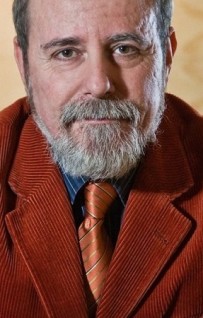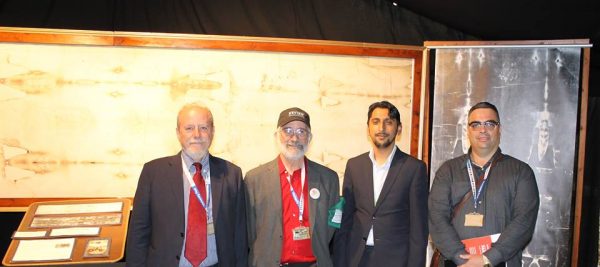The Shroud between science and faith; interview with Bruno Barberis

To read the interview in Italian, click here!
Bruno Barberis was born in Turin on March 1, 1953. In 1975 he obtained a Bachelor’s degree in Mathematics at the University of Turin. Since 1983 he has been serving as an Associate Professor of Mathematical Physics in the Department of Mathematics at Turin University. He has taught a variety of subjects, including rational mechanics, mathematical physics, mathematical analysis, approximation methods, electromagnetic waves, biomathematics, operational research, probability calculations and mathematical statistics.
His scientific research deals with cosmological models of homogeneous isotropic and anisotropic universes, the collapse of clustered matter, and inverse problems in Newtonian field theory. In these fields he has published over eighty papers in national and international journals. He has also participated in dozens of conferences in Italy and abroad on topics related to cosmology.
In 1975 he started to deal with the Shroud of Turin from the point of view of scientific research and since 1977 he is a member of the Confraternita del Santissimo Sudario (Confraternity of Holy Shroud) in Turin and of Centro Internazionale di Sindonologia (International Centre of Sindonology) in Turin: two organisations coordinating international studies and research on the Shroud of Turin.
From 1988 to 2002 he was President of the Confraternity of Holy Shroud and International Centre of Sindonology. From 2002 to 2016 he was Director of the International Centre for Sindonology. From 2017 he is Chairman of the Scientific Committee of the International Centre of Sindonology.
He has collaborated in the organisation of the Shroud exhibitions held in Turin in 1978, in 1998, in 2000, in 2010, in 2013 and in 2015, being appointed as a member of the commissions involved in the organisation of these large scale events. Since 1991, he has been a member of Commissione per la Conservazione della Sindone (Commission for the Conservation of the Shroud) and has contributed to the design and implementation of the new Shroud conservation methods, which were carried out in the decade 1992-2002. Since 2002, he has been a member of Commissione Diocesana per la Sindone (Diocesan commission for the Shroud), who has the task of collaborating with the Custode Pontificio della Sindone, Papal custodian of the Shroud, Archbishop of Turin, for carrying out any activity and initiative concerning the Shroud.
He has been a member of the Scientific Committee of dozens of meetings on the Shroud organized both in Italy and abroad, during which he has authored dozens of scientific reports on various topics, particularly on the application of probability calculations to the study of the identification of the man of the Shroud. He is the author of about twenty books and over 150 articles on the Shroud both at a scientific and popular level, published in national and international scientific journals and on monthly and daily international newspapers.
He has given more than 2800 lectures about the Shroud in Italy, Austria, Brazil, South Korea, Denmark, Finland, France, Georgia, Germany, Greece, Honduras, Israel, Mexico, Panama, Peru, Spain, United States, etc.
He has participated in numerous, international radio and television broadcasts on the Shroud and has collaborated as an editor and expert in the creation of numerous films, documentaries and DVDs on the Shroud.
In 2003 he was awarded the San Giovanni Prize for the City of Turin for his work as a scientist and popularizer of Turin culture in Italy and abroad.
In July 2017, Professor Barberis attended Jalsa Salana UK, the annual meeting of Ahmadiyya Muslim Community (the Community has always been interested in the Shroud), in Alton (not far from London), the last weekend of July 2017.
The event involved nearly 40000 people, and it has been defined, by English weekly The Economist, as the most important Muslim gathering in Western Europe (click here to read the article).
Within the Jalsa Salana UK a large space was dedicated to the Shroud, a major feature of the wider Review of Religions exhibition. The Review of Religions is the prestigious Ahmadiyya Community Magazine – printed for the first time, in India, in 1902 – and, together with Professor Barberis, were present: Barrie Schwortz (the official photographer of the first scientific examination of the Shroud in 1978) and the film director David Rolfe, author of the award winning documentary The Silent witness, for which he won a BAFTA.
Interviewer: Manuel Olivares;
Translation of interview from Italian into English: Manuel Olivares;
Editing of English version: Arif Khan.
Professor Barberis, we met at the annual meeting of Ahmadiyya Muslim Community: Jalsa Salana UK. How did you come in contact with the community and what kind of impression were you left with after the event?
A few months ago I’ve been contacted by Dr Abdul Fatir Malik, president of Community’s Italian section and I led him − with other English members as well − to visit the Museum of the Shroud in Turin. In that occasion I’ve accepted their invitation to attend Jalsa Salana 2017 and to give a lecture about scientific research on the Shroud. For me the experience I had this year, in Alton,has been very positive; I met many people who were very interested in the Shroud and its deep spiritual message.With them I’ve shared deep emotions and ideals.
Talking specifically about the Shroud, we know that the last opinion of science, in this regard, is that it is a fake made in medieval times. Do you think Carbon 14 test should be redone. Could you please explain why?
Immediately after the official announcement that the Shroud (October 13, 1988) is a fake, produced in the Middle Age, a chorus of controversy around the entire scientific process was unleashed, unfortunately fuelled by superficiality, imprudence, and in some cases by improper behaviour.
The most serious allegation claims that the samples analysed by the laboratories were not belonging to the Shroud but to a medieval cloth placed fraudulently in their place. One point to highlight is, unfortunately, the lack of a record of the removal of the sample. As a result we do not know with certainty neither the weights nor the size of the bloody cloth samples delivered to the three laboratories. The situation has also been compounded by some inconsistent and contradictory communications made by the leaders of the removal of the sample during some international conferences and congresses.
An important element of caution in uncritical acceptance of the results is related to the lack of multidisciplinary examinations to determine the type and quantity of foreign substances present on the samples being tested. Two American chemists, Alan Adler and Raymond Rogers, analysed a residual yarn of the Syrian sample used for radiometric dating; its infrared spectrum turned out to be different from that of the fabric and also exhibited particular characteristics with respect to the burial cloth. According to the authors, there is evidence to suggest that the site where the tissue’s samples were taken has been subjected to an externally invisible mending in the past and, therefore, the measured date, corrected from a strictly experimental point of view, would not correspond to the true age of the Shroud. In fact, during the operation to obtain the sample for carbon dating it was necessary to remove part of the sample for the clear presence of extraneous substances. However, it is evident that the levy on a single site is likely to provide homogeneous data but not representative of the whole subject.
The results of radiometric dating are still subject to a wide debate among scholars about the reliability of the use of the radiocarbon method to date an object with historical and chemical-physical characteristics as peculiar as the Shroud. Medieval dating contrasts with various results obtained in other research fields and it is also not easy to ascertain whether, over the centuries, no new C14 has been added to the one present at the time of the linen’s cut used to weave the Shroud. Studies on ancient tissues further reopened the scientific debate on the Shroud’s date, providing experimental results seeming to prove that biological, chemical, and textile contaminants are able to significantly alter the radiocarbon age of a tissue. Since the Shroud has certainly been subjected to biological (proved by the microstructures found on it), chemical (as a result of Chambéry’s fire) and textile (the texted area seems to have characteristics other than the rest of the tissue, presuming that it may have been mended) contaminations, the above-mentioned experimental results deserve to be carefully studied and verified through the implementation of a comprehensive research program and new examinations to assess the problem of introducing an appropriate correction at the radiocarbon date of the Shroud. Therefore, at present the problem of Syrian sample dating is open and not resolved yet.
Researching online I came across the thesis of one scholar who, starting with a scientific analysis of the Shroud, almost claims to be able to scientifically prove the Resurrection. Do you think it a will ever be possible to prove, scientifically a phenomenon such as Resurrection?
Of a “supernatural” event such as the Resurrection of Christ (and in general of any living being) there will never be a “scientific proof” because, by its intrinsic definition, Science – any science – was invented by Man in order to describe natural events: those happening in the world around us, we belong to and which can therefore be verified and analysed experimentally through direct or indirect observation (for instance through appropriate instruments). TheResurrection of a living being, obviously, is not among those events. This does not forbid, of course, a profound reflection on the fact that the Shroud reveals, without any doubt,the imprint left by the corpse of a human being(unique in the world with such characteristics) that, until now, no one has yet been able to reproduce using known methods and techniques (in spite of numerous, totally unsatisfactory, attempts) and therefore, till now, inexplicable.
Considering that, in your opinion, the carbon test 14 should be redone, is there any chanceitcould happen? In case the answer is yes, when and in which manner?
In order to be able to repeat the dating of the Shroud fabric using the C14 method, it is necessary first of all to know perfectly the physical-chemical characteristics of the whole Shroud, to identify the most suitable sites for extracting some samples. Therefore, it is necessary to create a detailed map by performing spectroscopic surveys with radiation of different wavelengths at each point of the sheet. Without this preliminary investigation, it would be easy to obtain meaningless results that could be easily criticized. In addition, they should be taken multiple samples of fabric fibers from various stretch points, to obtain a truly representative result of the entire sheet.
Reasoning, now, in abstract terms – that might also be incongruous for a person accustomed to relying on what is evident from a strictly scientific perspective – if we are able to prove that the Shroud dates back to the first century AD, how could we say it is, exactly, the sheet that has wrapped Jesus?
To scientifically analyse the credibility of the identification, which tradition has always justified, between Jesus of Nazareth and the man of the Shroud, it is necessary to compare the descriptions of Jesus’ passion, death and burial in the four canonical gospels with the features of the double imprint of the Shroud, identifying the common characteristics of the two subjects. At this point you can use the calculation of probabilities (that field of math dealing with calculation of degree of reliabilitythat can be attributed to the occurrence of a given event) to quantitatively evaluate – relying solely on objective considerations, entirely out of every a priori hypothesis – what is the probability that these common characteristics may have belonged to any crucifix of history.
Let’s examine the main characteristics common to Jesus and to the man of the Shroud:
1) The man of the Shroud and Jesus after death were wrapped in a sheet. This is a very rare fact in ancient times, especially for a crucifixion. In most cases, the corpses of the crucified were abandoned on the cross to the wild animals or buried in common graves,
2) Upon both the man of the Shroud and Jesus has been placed a thorn helmet on his head. This fact is truly exceptional and we do not possess any document reporting such a custom either among the Romans or other peoples,
3) The Man of the Shroud, like Jesus, carried a heavy object on his shoulders, which can only be the patibulum (cross-beam of the Crucifix) to which he was nailed,
4) Both the man of the Shroud and Jesus were fastened to the cross with nails. This fact seems to have been reserved for official crucifixions, while in the majority of cases the convicts had their hands and feet tied with ropes,
5) The man of the Shroud and Jesus were injured at the cost after death, without presenting fractures to the legs. It is practically unique: it was more common to break the legs to crucified people to speed up their death (as John’s Gospel explains) when it was necessary to anticipate the conclusion of the execution,
6) The man of the Shroud and Jesus were wrapped in the funeral sheet just deposited from the cross, without any washing and unction of the corpses. This does not correspond to the customs of the time where corpses were washed and anointed with aromatic plants and herbs wrapping them in the funeral towel for regular burial. This is therefore an exceptional case for which some external factors have occurred which have led to a hasty burial, postponing the final one. In the case of Jesus we know that he was wrapped in a sheet and placed in a tomb immediately after the deposition from the cross before the evening came and Easter began during which no manual work could be performed. The final burial should have been performed by women two days later,
7) Both the man of the Shroud and Jesus remained in the sheet for a short time. In fact, in order for the image we see to have been produced, it was necessary for the body to remain in the sheet for at least twenty-four hours but not more than two or three days, otherwise the decomposition process would have destroyed the image or left still visible and recognizable spots that are not present on the Shroud. This fact is really amazing because it does not seem reasonable to put a dead body in a sheet (something unusual in ancient times) to enter very soon in the tomb, removing it after such a short time. Even Jesus was wrapped in a sheet just after the deposition from the cross and, after a period of no more than forty hours, in the tomb, watched by a guard, just the sheet was found while the corpse was not there anymore.
It has been assigned one probability to each of these seven characteristics common either to Jesus and to the man of the Shroud, giving a greater value to those which, more likely, have belonged to any crucified and a lesser value to the rarest ones.
At the end of this calculation, the total probability – that is the probability that these seven events occurred at the same time, or that these seven characteristics were all united together on the same man who suffered the crucifixion, was equal to 1 divided 200 billion. This means that over 200 billion crucified men, just one would have possessed the seven characteristics common to the man of the Shroud and to Jesus. Since it is evident that in the history of mankind it is not possible 200 billion men have been crucified (at most a few hundred thousand or a few millions), the calculation made allows to conclude that it is very high the probability that a crucified with these characteristics is unique and that, therefore, the man of the Shroud is Jesus of Nazareth.
What do you think of the Ahmadiyya thesis about the Shroud? That the body wrapped in the sheet was Jesus’ one but it was alive and not dead?
As I have already said, the scientific studies and analysis carried out on the human imprint on the Shroud lead to the highest probability that it has been left by the body of a tortured and crucified man and not by a man who was still alive. For the Christian faith it is indisputable that Jesus of Nazareth died on the cross, was wrapped in a sheet, buried in a tomb and risen from death after no more than a day and a half. Such certainty of the Christian faith does not rely on the Shroud but on many other assumptions such as the Gospel texts, historical testimonies and the secular tradition of the Church. I respect Ahmadiyya community’s thesis, which is evidently based on a different approach and interpretation of the evangelical and historical texts. In this regard, I think that every discussion is always useful and positive, provided it is constructive and respectful of different points of view and interpretations even when they are in opposition.
Finally, couldyou give us some clarifications, considering the title of a text you had co-authored about a “possible dialogue between Shroud, science and faith”?
Reading, studying, and meditating on the visible image of the Shroud leads mostly to two levels of reflection. On the one hand, the study of the image presents a very high interest from the scientific point of view. Especially in the last 40 years, scientists have been trying to understand the characteristics and origin of the study, starting studies in the most diverse fields of science: physics, chemistry, biology, computer science, legal medicine, statistics, and so on. In these years the Shroud was at the centre of a wide, articulated and ardent multidisciplinary scientific debate. On the other hand, tradition has always identified the Shroud with the funeral sheet of Jesus of Nazareth and in more recent times this identification has taken advantage of modern exegetical studies with significant results. This obviously affected the field of Christian faith, thus opening up a passionate debate on the relationship between the Shroud and the Faith. The two ways of understanding the Shroud have often met and clashed, dividing both the workmen and the common people: Shroud object of faith and of veneration or object of scientific interest and study? Often in these last years the two approaches to the Shroud have been opposed, as if one necessarily excluded the other. Then it has developed a remarkably animated debate, perhaps as never before, favoured by modern media and the great interest provoked worldwide by the last public exhibitions. For a scientific approach it is normally understood that the Shroud is considered solely as an object of study and with which we are just facing the problem of trying to solve the questions about its origin and authenticity. For the pastoral approach we mean considering the Shroud in the light of its intrinsic message that, starting with its close and indisputable relationship with the Holy Scriptures, comes to be a precious and unique inspirer of the life of faith and the source of inspiration for those charitable activities being its authentic, great fruit.
Very often I’ve been questioned about the possibility that sooner or later there may be a definitive and absolutely certain conclusion on the authenticity of the Shroud. For reasons of scientific rigor, such questions have to be answered in probabilistic terms, expressing (as I have already stated above) what is the probability that, based on current knowledge, this result corresponds to the truth, but of course knowing that new discoveries or new knowledge can change or even overturn the results that have come to today. But are such considerations still valid even when compared to scientific studies and religious reflections? Obviously if such studies have the same purposes. But if the goals are different or are even on uncompromising dimensions, things change radically. That’s exactly what happens in the field of studies on the Shroud. The religious approach described above can never have the purpose of investigating the historical-scientific authenticity of the sheet and its image. On the contrary, it has the not secondary purpose to read the Shroud in depth, with the intent of grasping the essential message from that image, thanks to its perfect resemblance to the story of Jesus of Nazareth, in particular with his passion, death and Resurrection. It is evident that such a religious approach can rely on the results of historical-scientific investigations, but it does not really depend on them because it does not seek to find answers to the authenticity of the Shroud. Therefore, to consider the scientific approach as incompatible with the religious one it is meaningless and very dangerous because on the one hand it could reduce the Shroud to a “dead object”, to an image having sense only in itself, without involving our own life, transforming the Shroud into a sort of idol enslaved to a priori and instrumental thesis. But are the two ways to relate to the image really diametrically opposed? Personally, I believe that the two approaches are not only compatible but complementary, as both are indispensable for a correct, effective and complete presentation of the Shroud. They can very well coexist, provided that the various disciplines are respected and that they do not want to mix all the time by forcing conclusions without respecting their peculiarities. In this regard, it is important to emphasize, in the face of misunderstanding, that Christian faith will not be founded on the Shroud, but on many other assumptions.
We can, then, conclude a proper presentation to all those who stand before the Shroud free from preconceptions and prejudices could give the opportunity to go through a precious journey of reflection to the discovery of the mystery of Jesus’ passion, narrated in literary form from the Gospel texts. This path needs to be supported both by the confirmations and discoveries that come from the scientific studies of the Shroud image and by the reflection that allows us to go beyond the image to grasp in its entirety the message of salvation and redemption given to us by suffering of Christ in the long and painful journey of his passion. The Shroud, therefore, absolutely needs to be studied and understood by following both approaches: the ones of science and of faith. Otherwise, it will be impossible to catch deeply its profound message.
Jalsa Salana UK, 2017
From the left side: Bruno Barberis, Barrie Schwortz, Arif Khan (Review of Religions), Manuel Olivares.


 English
English Italian
Italian